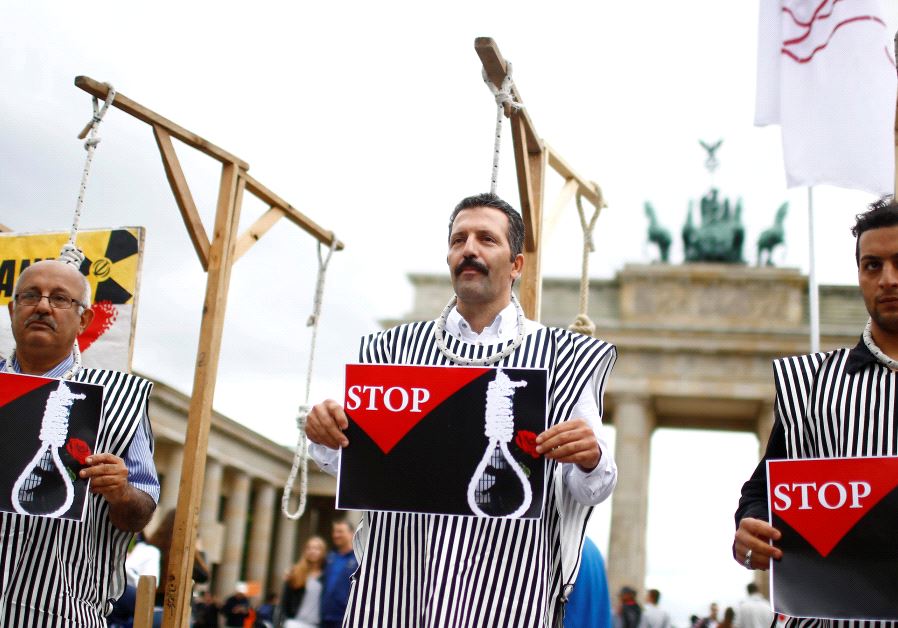Iran’s attack on Kurds is a message to Washington, Riyadh and Jerusalem

People stage a protest against the execution by Iran of up to 20 Kurds.. (photo credit: REUTERS)
The Islamic Revolutionary Guard Corps (IRGC) in Iran claimed credit for a missile attack on Kurdish opposition groups in Koya in northern Iraq. The attack on Saturday killed a dozen and wounded numerous others. It was the first time Iranian forces had used this kind of precision missile attack deep inside Iraq. The brazen daylight missile attack is a message from Tehran to the region that it can do what it wants, not only in neighboring Iraq, but throughout the Middle East. In the last year Iranian missiles and Iranian-supported groups using Tehran’s technical advisors have targeted Saudi Arabia from Yemen and Israel from Syria. As Washington seeks to pressure Iran, the missile threat is clear indication that Tehran is flexing its muscles in the face of sanctions.
The IRGC attempted a decapitation strike against the Kurdish KDP-I, an opposition group that has a headquarters in Koya. Numerous senior leaders were present and a missile crashed into the building where they were meeting. This was a precise and unprecedented strike. Although Iran has targeted Kurdish groups in Iraq before, and it has fired missiles at other opposition groups, the missiles used in this attack were precise and showcases Iranian intelligence operations and know how.
The missile attack on Koya should not be seen as an isolated Iran regime attack on an opposition group. Iran has been fighting Kurdish opposition for years and in Iran there have been increasing clashes. But the missile strike was an escalation and should be seen in the context of the Iranian-backed Houthis using ballistic missiles to target Riyadh, flying some 900 km from their launch point. Iranian forces from Syria have also targeted and tested Israel’s defenses. They flew a drone into Israeli airspace in February and fired a salvo of missiles in May. Recent satellite images show missile production facilities in northern Syria. Reports also indicate that Iran has transferred missiles to the Hashd al-Shaabi, or Shia militias, in Iraq. And Iran has armed Hezbollah with missiles for years and also supplied Hamas with technical support.
The big picture then is an Iranian missile threat throughout the region. The National Defense Authorization Act signed by US President Donald Trump in August included passages about Iran’s ballistic missile threat. Congress had looked deeply into how Iran’s missile program threatens the region. During a June speech at the Foundation for the Defense of Democracies US Under Secretary of the Treasury for terrorism and financial intelligence Sigal Mandelker said that “Iran must end its proliferation of ballistic missiles.”
US allies in the region have missile defense technology to confront the Iranian threat. Israel has a layered system of missile defense included Iron Dome, David’s Sling and the Arrow program, while Saudi Arabia has used Patriot missile batteries to stop the Houthi missiles. This has proven effective. It is also why the IRGC decided to test out its missiles by targeting defenseless Kurdish groups in northern Iraq.
The IRGC’s strike on the Kurds is a message to Washington and to Israel. It shows how the IRGC operates across borders and across with the region, seeing Iran’s policy in Yemen, Iraq, Syria and Lebanon as linked into one larger program. The IRGC is also the group responsible for working with various proxies and Shia militias across the region. The US administration’s response to the missile attack in Iraq will reveal whether Washington takes this new front in northern Iraq seriously and whether the discussions about stopping Iran’s activities see Iraq as a frontier to confront these missile threats, or whether Iraq will continue to be an area that Iran can operate freely in.
Join Jerusalem Post Premium Plus now for just $5 and upgrade your experience with an ads-free website and exclusive content. Click here>>






Comments are closed.